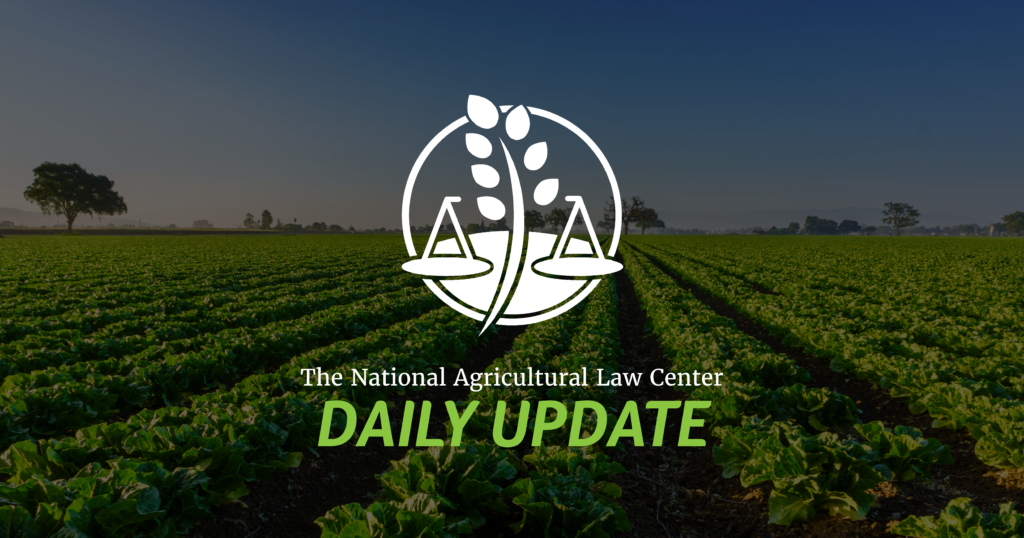A comprehensive summary of today’s judicial, legislative, and regulatory developments in agriculture and food. Email important additions HERE.
REGULATORY: USDA, EPA
ENVIRONMENTAL PROTECTION AGENCY
Final rule establishing tolerances for residues of fluazinam in or on multiple commodities. Interregional Research Project Number 4 requested these tolerances under the Federal Food, Drug, and Cosmetic Act. Info here.
Final rule establishing tolerances for residues of pyraclostrobin in or on pomegranate. Interregional Research Project Number 4 requested these tolerances under the Federal Food, Drug, and Cosmetic Act. Info here.
Final rule announcing that the EPA issued a final rule in the Federal Register of April 7, 2021, establishing tolerances for residues of the insecticide spinetoram in or on multiple commodities requested by the Interregional Research Project Number 4 under the Federal Food, Drug, and Cosmetic Act. That document inadvertently instructed the Federal Register to add a tolerance for “vegetable, leafy, except Brassica, group 4” and to remove a tolerance for “vegetable, leafy, group 4-16”. EPA is correcting the final regulation. Info here.
DEPARTMENT OF AGRICULTURE
Notice announcing that the U.S Codex Office is sponsoring a public meeting on October 19, 2021. The objective of the public meeting is to provide information and receive public comments on agenda items and draft United States (U.S.) positions to be discussed at the 42nd Session of the Codex Committee on Nutrition and Foods for Special Dietary Uses (CCNFSDU) of the Codex Alimentarius Commission, which will take place virtually November 19-25, 2021, with report adoption on December 1, 2021. Info here.
JUDICIAL: Includes environmental law
In Food & Water Watch v. U.S. Env’t Prot. Agency, No. 20-71554, 2021 WL 4203496 (9th Cir. Sept. 16, 2021), the Ninth Circuit Court of Appeals considered whether a permit issued under the National Pollutant Discharge Elimination System (“NPDES”) for a Confined Animal Feeding Operation (“CAFO”) in Idaho should be vacated. Two environmental organizations, Food & Water Watch and Snake River Waterkeeper (“Petitioners”) challenged the permit, arguing that its issuance was arbitrary, capricious, and in violation of law because it lacked sufficient monitoring provisions to ensure compliance with its discharge limitations.
On October 23, 2019, the EPA issued for public comment a draft permit and fact sheet for Idaho CAFOs. On May 13, 2020, the EPA issued the Idaho permit, with an effective date of June 15, 2020. The Idaho permit forbade discharges of pollutants from production areas. Additionally, the permit forbade discharges of pollutants from land-application areas. Wet-weather discharges were permitted only when manure, litter, and process wastewater had been applied in accordance with a site-specific nutrient management plan. Dry-weather discharges from the land-application area were flatly prohibited.
The court discussed the requirements of an NPDES permit and how they must ensure that discharges comply with effluent limitations in the permit. Petitioners argued that the permit lacked sufficient monitoring provisions to ensure compliance with the Permit’s “zero discharge” requirements, for both production and land-application areas. The court held that the issuance of an NPDES permit is arbitrary, capricious, and contrary to law if the permit fails to include monitoring provisions that ensure compliance with the permit’s effluent limitations.
The court concluded that the Idaho permit forbade underground discharges from production areas and dry weather discharges from land-application areas. However, the permit contained no monitoring requirements for either kind of discharge. The court held that because the permit did not require monitoring that would have ensured compliance with its effluent limitations, the EPA’s issuance of the permit was arbitrary, capricious, and a violation of law. The court granted the petition and vacated the permit.
